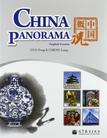中国概况
2012-5
高等教育出版社
郭鹏 等编著
212
359000
China Panorama is intended for the use by international
students coming to China to study the required course "China
Panorama". As well as reading material for all of those studying
Chinese as a second language, this book is the top choice for
learning Chinese culture and motivating students' interest. This
book introduces topics such as Chinese geography, culture, history,
international relations and the development of the nation.
Readers will find they are inspired, challenged and provided with
cultural facts throughout the learning process. In the practice
sections, lots of thought provoking and practical exercises are
set, encouraging intercommunication between book and readers,
teacher and students. It achieves the perfect match of cultural
awareness and students needs.
GUO Peng,He graduated from Peking University with Doctorial
Degree on Chinese Literature in 1997. Now he is a professor of
College of Chinese Studies at Beijing Language and Culture
University.
CHENG Long,He graduated from Peking University with Doctorial
Degree on Chinese History in 2004. Now he is an associate professor
of College of Chinese Studies at Beijing Language and Culture
University.
JIANG Xiliang,He graduated from Beijing Language and Culture
Uruversity with Master's Degree on Chinese Literature in 2010. Now
he is working at the President's Office of Beijing Language and
Culture University.
WANG Qun,She graduated from Portsmouth University in the UK with
Master's Degree on Management of Education and framing in 2008, Now
she is an editor at Higher Education Press.
Preface
Reader's Guide
Index of Pictures
Chapter 1 The Geographical Environment and Chinese Culturt
The Main Characteristics of China's Geographical Environment
The Influences of Geographical Environment over
China's Agricultural Civilisation
Confucianism and Ancient Agricultural CMlisation
Agriculture and Changes in Population and Language
Activities
Chapter 2 The History and Society of China
The Early History and GMlisation of China
Confucius and His Influence
The Rise and Fall of Ancient China
China's Transition to a Modern Society ActMties
Chapter 3 Chinese Traditional Thoughts
Pre-Qin Times:The Making and Prosperity of Chinese Thought
Integration and Vibrancy of Thought in the Han Dynasty
Great Boom of Thought and Wei-Jin Style
Creative Efforts in Thought in the Tang Dynasty
Neo-Confucianism in the Song and Ming Dynasties: Recreation of
Confucianism
Enlightenment of Three Great Philosophers of the Early
Qing Dynasty
Activities
Chapter 4 The Lives of the Ancient Chinese
Basic Necessities of Ancient Chinese
Language and Characters of Ancient Ghina
The Glamour of Chinese Traditional Arts
Customs and Ceremonies of Ancient Chinese Society ActMties
Chapter 5 China's Contribution to the World's Science and
Technology
The Papermaking and Printing Technology of Ancient China
The Silk and Porcelain of China
The Unique Traditional Chinese Medicine
The Achievements of Mathematics and Astronomy of Ancient
China
Activities
Chapter 6 Migration and China's Social Changes
The Major Migrations in Chinese History
Influence of the Migrations on Chinese Language
Migrations in Modern Ghina
Overseas Chinese and the Spread of Culture
ActMties
Chapter 7 Awareness and Collision Between China and the West
Marco Polo and The Travels of Marco Polo
Matteo Ricci and the Spread of Western Civilisation in China Ming
and Qing Emperors' Promotion of the Western
Gulture Spreading in China
The Controversy over the Etiquette Rite and the End of Catholicism
in China
ActMties
Chapter 8 China in Modern Times and Western Civilisation
Modern China's First Batch of Figures Learning from the Outside
World and Their Works
……
Chapter 9 The Life of Contemporary Chinese People
Chapter 10 Political System and Basic Poliaes ofChina in the
Present Age
Chapter 11 China Gradually lntegratinginto the lnternational
Community
Appendixes ABriefChronology of Chinese History
版权页: 插图: Chinese is truly an ancient language and is one of the longest livedlanguages in the world,with the most number of speakers of any language inthe world today,Chinese is thus starting to become one of the most studiedforeign languages.The changes undergone by the Chinese language is afascinating question and not one that has a simple answer.The language used inChina today,is the modem version of ancient Chinese that evolved throughoutthe ages.The clearest change to the Chinese language came about during theMay-4th Movement of 1919 which was a watershed in language reform,bringing about many simplifications to Chinese grammar.Older versions ofChinese employed a written language known as the classical style of writing,a form that differed significantly from how people actually spoke.This writtenform remained fairly standardized throughout much of Chinese history for thewriting of official documents.Nowadays,people find this form quite difficultto read.since the modern Chinese written form has been altered to reflect howChinese is actually spoken. According to legend,several thousand years ago during the time of theYellow Emperor what is now China consisted of some 10 000 separate clans.Bythe time of the Xia the figure was around 3 000 and by the time of Zhou therewere 800 independent nation states.As one can imagine,each nation spoke theirown distinct dialect and SO with such variety in the spoken language the onlyway to maintain any open form of communication was to develop a commonwritten form.During the Zhou period some semblance of uniformity wascreated under the Zhou hegemony system and the first unified Chinese script,or"elegant language",was invented which was used up until the time of the Qinempire and thus formed the basis of the written language.After Qinshihuangunified China,in order to maintain unity and prevent separatism,he promulgatedthe very first full set of uniform characters to be used throughout China.
《中国概况(英文版)》是面向以汉语作为外语学习者的普通读物,尤其针对已经比较系统地学习了两至三年汉语、并对中国有一定了解的外国学习者,同时也可作为来华留学生高年级本科生以及研究生的中国概况类公共课教材。《中国概况(英文版)》是普及中国文化、激发学习者对中国文化兴趣的首选教材,有选择地、客观地介绍了中国的地理特点、文化基质、历史变迁、对外交流、发展动力等。
